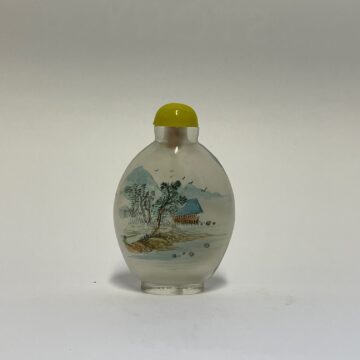“Two pieces of anything make a collection. Three pieces become an absolute bore.” – Bernard Spitzer

Peking glass is a unique style of 18th century Chinese glassware known for its aesthetic appeal and collectability. The Rosenberg Library received its collection of Peking glass from Bernard Spitzer (1923-1989), an interior designer and art collector in Galveston. Spitzer frequently volunteered at the Library and decorated the Colonel Milo Pitcher Fox and Agness Peel Fox Rare Book Room when it was first dedicated in 1967.
Spitzer amassed an eclectic collection of glassware, porcelain, crystal, and more. He selected objects for their aesthetic appeal rather than monetary value, and never collected more than a couple examples of an item or style. Spitzer displayed his collection as part of his store, Bernard Spitzer Interiors Inc., located on Tremont Street and closed after his death in 1989.

A Complicated Process
Peking glass is made up of several layers of glass that are then carved away to form a raised image. The glass blower creates a base shape for the object and then dips it into molten glass several times. Artisans often used different colors of glass for the layers in order to create contrast, as seen with this blue and white bowl. “Imperial Yellow” was a popular color for Peking glass, as it was associated with the Qing Imperial Clan and symbolized prosperity. Other frequently used colors included green, red, and blue.
The carved designs often included flowers, animals, and landscapes, similar to the traditional designs used in other Chinese art forms. The objects in our Treasure of the Month display have motifs of chrysanthemum flowers, butterflies, grapes, and squirrels. All of these symbolize happiness, longevity, and abundance.

History of Peking Glass
Peking glass first originated in Peking, China during the Qing Dynasty (1636-1912), and achieved its greatest popularity during the reign of the Qiánlóng Emperor, from 1735 to 1796.
Glass was a relatively new medium for Chinese artisans, who traditionally worked with precious stones like jade, lapis lazuli, ruby, and emerald. In the 18th century, European missionaries to China brought new technologies with them, including glass-making. An Imperial workshop was set up in Peking to manufacture glass, which was cheaper and easier to carve than precious stone. Glass objects quickly became just as desirable as their more expensive counterparts, and the majority of Peking glass was exported to other countries due to high demand from Western collectors.
Snuff bottles made of Peking glass were particularly desirable. Along with glass-making techniques, Westerners introduced the practice of snuffing tobacco to Chinese nobility. Snuff bottles became a status symbol and a collectible, and were often exchanged as gifts to other court members or to foreign diplomats.

The Treasure of the Month is located on the library’s historic second floor near the East Entrance. It can be viewed during regular library hours, 9:00 a.m. to 5:45 p.m. Monday through Saturday. For museum questions, call 409.763.8854 Ext. 125 or email museum@rosenberg-library.org. For press inquiries, contact the Communications Coordinator.